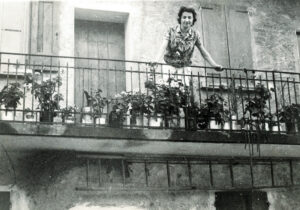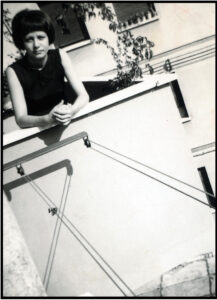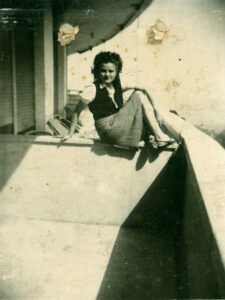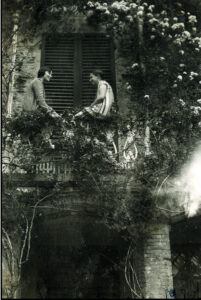The exhibition entitled Nice Balconi draws from the vernacular photography archive by Sergio Smerieri from Modena to tell the story of the balcony, the absolute protagonist in dozens of images buried in grandmothers’ drawers, in attics and in antique markets. The exhibition revolves around the architectural artifact for which Verona is famous at all latitudes. The balcony that never appears in Romeo and Juliet (Shakespeare does not write about any balcony, neither in the captions nor in the dialogues. He rather speaks of an “orchard scene” or “garden scene”), has always been an occasion to exhibit the private, to observe looking out onto the world, but at the same time showing oneself peering down from above. The balcony is a tinsel that enhances the home and a status symbol of post-war well-being.

The balcony is theater in the street and recently, in the pandemic period, an opportunity to socialize. On the balcony many artists posted their characters, quoting each other, such as Francisco de Goya, Édouard Manet and René Magritte, who closes the game with Perspective II. Gustave Caillebotte stretched a divergent perspective with his Young Man at the Window, Rem Koolhaas included the balcony at the Venice Biennale, and illustrator Agathe Sorlet still makes it an outward extension of intimacy and private. At the beginning of the famous Un chien andalou – the short film made in 1929 by Luis Buñuel and Salvador Dalí – a man watches the moon from the balcony. He sharpens his razor and with one cut renews the sight that will have to await the new man: the hermaphrodite. The balcony is between heaven and earth, an alchemical passage between the elements, a suspension before a transformation necessary for renewal. The balcony looks out from the known to the unknown which announces itself with prophecies of unity. It is not the summit on which the Manichean struggle between good and evil is mythically celebrated, because that takes place on the turreted summit. The balcony is rather tension full of conditional dynamics and hypothetical variables. The performer Matthew Barney completes his apprenticeship challenging the Guggenheim balconies in his epic Cremaster Cycle. Art training is physical exercise to be subjected to the test of gravity in the dynamic tension of a rising body.

In vernacular photography by Sergio Smerieri, exhibited for the first time in Verona, it is momentarily recovered the pleasure of bringing the image back to the frivolous, exonerating itself from the seriousness of post-avant-garde experimentation. The artist does so from a balcony of time and on time. Shots yellowed by time of common protagonists, men, women, children who sunbathe on terraces and balconies, show their families or converse with their neighbours. From the balcony it was announced that Italy was an Empire and again from the balcony the pope presents himself to the crowd of St. Peter’s. The balcony, halfway between earth and sky, is a metonym for the domestic. In dialogue with the vernacular photographs there will also be shots of more recent balconies taken by the students of the Forms and Languages of Art course at MSTC Iusve.

Together with the exhibition on the balconies, which will open on February 4th at 6.30 pm, Isolo17 Gallery also hosts the Carlo e Luciana project by the legendary Erik Kessels and Sergio Smerieri. The project tells the story of the journey of a man and a woman through Europe, during which each takes pictures of the other. The pairs of images taken by Carlo and Luciana, which complement each other side by side like halves of a whole, were selected and ordered by Kessels and Smerieri to create a compelling visual story. “Carlo and Luciana were a couple from the Italian town of Vignola, in the province of Modena. The couple made a small handful of trips soon after the wedding. Only later, beyond the symbolic blank pages of the years, we can really know how Carlo and Luciana explored the world. Black and white becomes color, we witness the passage of time. Together they create a curious contradiction; two halves each with its own different pattern, forming a whole”.

Erik Kessels – who will be exceptionally present at the opening – is a Dutch artist, designer and curator, he collects photographs that he finds in flea markets, fairs, second-hand shops, recontextualizing them. Among his most famous and important works there are the magazine Useful photography and In Almost Every Picture. The organization is curated by Grenze Arsenali Fotografici in collaboration with Gu.Pho and Isolo17 Gallery.
All the images come from Sergio Smerieri’s archive; he authorizes us to publish them in the article
Info:
Nice Balconi di Sergio Smerieri
Carlo e Luciana di Erik Kessels e Sergio Smerieri
04-28/02/2023
Mon – Fri. by appointment only 15.00 – 19.00 cell: 327 7341027
Saturday and Sunday from 10.00 – 12.00 and 15.00 – 19.00.
Isolo17 Gallery
Via Venti Settembre, 31b Verona
www.isolo17.gallery

He is an art critic and professor of Contemporary Art History at IUSVE. He also teaches Critical Image Reading at the Palladio Institute of Design in Verona and Contemporary Art at the Master of Publishing at the University of Verona. He has curated several contemporary art exhibitions in unconventional places. He is the artistic director of the Grenze Photography Festival. He is a theater critic for national magazines and newspapers. He organizes research and experimentation theatrical events. Among the recent publications Frame – Videoarte e dintorni for the University Library, Lo Sguardo della Gallina for Lazy Dog Editions and for Mimemsis Smagliature in 2018 and 2021 for the same publishing house, Theater and photography.






NO COMMENT